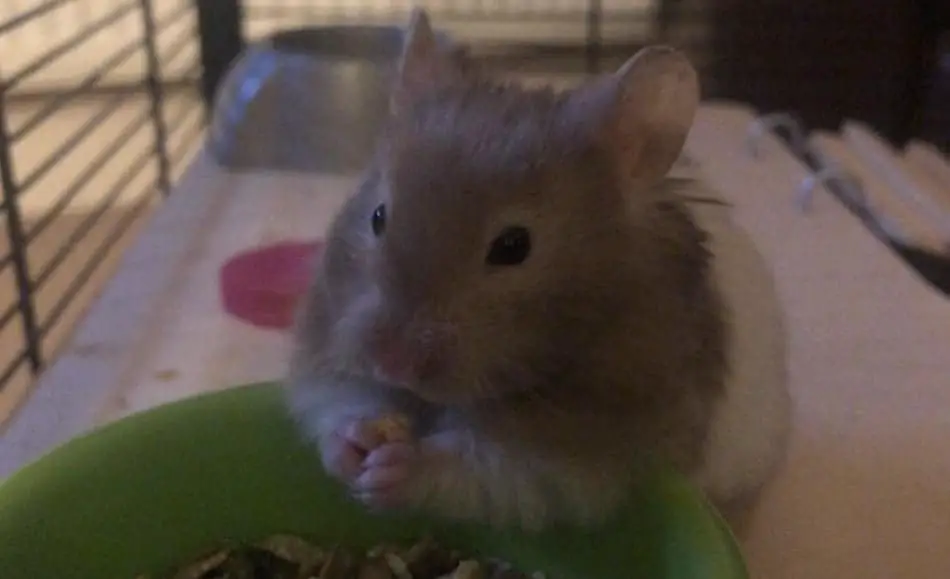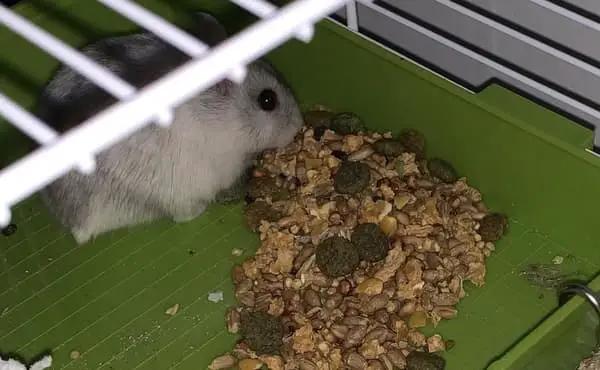For being so small, hamsters are quite complex creatures which often comes as a surprise to humans. They have a lot of energy and big personalities squeezed into tiny bodies, so when they do strange things like put food in their running wheel, it can leave us scratching our heads. Not to worry, however, as this behavior likely is harmless.
So, why does my hamster put food in her wheel? The most likely reason is because your hamster is hardwired to hoard its food, even in strange places. There may be other factors affecting the behavior, however, there most likely is no cause for concern.
In this article, we will discuss your hamster’s natural inclination to hoard and burrow, conditions under which it could become bored and how to combat that, as well as personality preferences of our tiny pals.
Tiny Doomsday Preppers
Hamsters have only been in our homes for about a century, making them some of the most closely related domestic mammals to their wild counterparts we know. This means the wild instincts that drive hamster behavior in their native habitats are still extremely strong in our furry domestic friends.
Wild hamsters are hoarders, meaning they forage for food to stuff into large cheek pouches for transport back to their homes where they stockpile it in preparation for a rainy day (sometimes literally). In the wild, hamsters inhabit burrows they have excavated into tunnels and interconnecting rooms in which they store said stash.
Living this way allows wild hamsters to ensure a steady food source in scarce desert and steppe environments, helps keep their food fresh, and helps keep both their food and their presence hidden from potential competitors or predators nearby.
Although our domestic companions have no need to fear food insecurity or predators, the instinct to hoard food is still incredibly strong and drives many of their odd behaviors. If you have a furry friend who likes to put food in their running wheel, it likely is no cause for concern as they are simply storing their stash.
Of course, while this seemingly presents some logistical problems for the hamster when it wants to run on the wheel, many hamsters do not seem to mind all that much. The biggest problem this behavior poses to you is the noise the food makes while it rolls around the wheel.
If you do not want your hamster to put food in its wheel, make sure there are plenty of other places for your hamster to hide itself and its food. Hamsters often like to eat where they hide their stash because it feels safer to them. Many hamsters have more than one stash, but if there are not enough available places, they may resort to the wheel.
Again, this behavior is normal and not harmful, but if you prefer that your pal not store food this way, add some extra hides and/or tubes, add an extra layer of bedding, or try relocating the wheel to another area in the enclosure. Your hamster may continue to store food in the spot where the wheel was previously, simply because it just likes that spot.
Hoarding is not the only instinct to follow our furry friends into our homes; hamsters also have a strong natural drive to burrow.
Hamster Homemaking
As discussed above, hamsters burrow and live underground within an extensive network of tunnels and rooms used for sleeping, food storage, toileting, raising babies, and more. To create these intricate living spaces, hamsters dig deep down, between two and eight feet depending on the breed, into the dry, rocky soil they typically inhabit.
This requires a lot of energy and even more persistence, and must be done to keep the hamsters, any potential offspring, and most importantly to these little hoarders their food, safe from the elements, competitor animals, and predators.
This means our tenacious little friends both in the wild and in our air-conditioned homes have an incredibly strong instinct to burrow.
Domestic hamsters often burrow in their enclosures to burn off energy, release built-up stress, hide their food stashes, nest during pregnancy, or simply for the sake of burrowing. Our furry homebound companions do not always have the amount of space their wild cousins might, so sometimes burrowing to them looks a little odd to us.
Your pocket-sized pal might see its wheel as a potential ready-made “room” for food storage since it likely does not have eight feet of digging space to create the lavish living area it may want.
If you think perhaps this is what is driving your pal’s behavior, consider giving it some more digging opportunities in the form of a dedicated box in its enclosure, a partitioned part of its enclosure filled with more bedding material, or an addition to its enclosure connected with tubes.
This will ensure your friend has lots of space to dig, and plenty of places to make new food stashes. Another factor to consider, especially if your furry friend does not seem to have enough space to dig or places to hide food, could be boredom.
Help, I’m Bored!
Hamsters are extremely busy little beings. They live on a high-energy diet rich in carbohydrates, they survive in the wild by scampering across great distances in short periods of time to forage for food, and of course as we just covered, they dig, dig, and dig some more.
Because of all these things, they are like tightly coiled springs with tons of potential energy that is just waiting to be released. If a domestic hamster does not have enough outlets for this energy, they can easily become bored, which can lead to adverse conditions.
Hamsters are capable of a broad spectrum of emotions despite their size and at-first-glance simplicity, such as happiness, sadness, optimism, depression, and yes, boredom. A bored hamster might sleep more often (but keep in mind our furry friends are nocturnal!) or exhibit lethargy; conversely, a bored hamster may also exhibit hyperactivity or compulsive behaviors.
It is important to be able to determine what your pocket-sized pal is telling you when it exhibits these signs. Boredom often leads to stress and anxiety in hamsters, so in addition to signs of boredom, be on the lookout for signs of stress, like these:
- Uncharacteristic hyperactivity
- Compulsive behavior (bar chewing, destructiveness, incessant scratching, gnawing)
- Unusual habits or sudden behavioral changes
- Uncharacteristic aggressiveness
- Snorting or grunting
- Excess salivation
- Persistent escape attempts
- Muscle rigidity or tremors
If your hamster is exhibiting symptoms like those above coupled with signs of boredom, and its wheel food storage habit is new, consider enriching your pal’s enclosure to give it more options for energy expenditure and stress relief.
In addition to its exercise wheel, give your furry friend some tubes, hides, and ladders with extra levels in its enclosure that it can scamper through and climb. Add some toys, chew blocks, and digging space as discussed previously, and make sure the enclosure itself is large enough for your companion.
Depending on the breed, try to ensure the enclosure is at least 24 inches by 12 inches, with 12 inches of height; however, bigger is usually better despite the small stature of our friends. Further, give your pal some supervised time outside of its enclosure in a hamster ball so it can explore the rest of your home and burn off even more energy. A busy hamster is a happy hamster!
Speaking of happy hamsters, if you have read this far and none of these factors seem to fit your pocket-sized pal’s behavior, it might simply come down to personal preference.
Individual Preferences
Hoarding instincts aside, hamsters are just like us and many other mammals and have their own unique personalities and preferences. In some studies, hamsters even demonstrate “moodiness” like our own! For example, some hamsters like having several food stores, while others keep all their food in a bowl and cover it up there. If you’re curious about hamster hoarding food behavior, these individual differences in food storage methods showcase the diverse and intriguing personalities these small creatures possess.
Many hamsters love snuggling with their humans while others prefer enjoying our company at a respectable distance. Further, some hamsters seem to be obsessed with running in their wheel while others may never set foot in theirs. If your furry friend makes a habit of storing food in its wheel, it might simply enjoy having its food there.
That could mean it enjoys quick access to a snack while it is running hamster marathons, or it just likes the sound of food rattling around while it goes. In any case, this behavior is almost certainly no cause for concern, aside from perhaps waking you in the middle of the night when your pal decides it is time to run with all that food in its wheel!
Conclusion
If your hamster has been storing food in its running wheel, it most likely is being driven by its instinctual drive to hoard. Further, it could be compelled by its burrowing instinct and need to find “rooms” in which to put its food.
Your furry friend could be suffering from boredom and subsequent stress, so make sure there are plenty of enriching activities for it to burn off its energy to combat anxiety. Beyond these factors, your companion may simply have a personal preference for having food in its wheel while it runs.
If your pocket-sized pal is happy and healthy with no signs of stress, this behavior is no cause for concern aside from a slight noise issue if you are sensitive to it. There are a few things you can do to try to dissuade this behavior, but overall, it will not harm your furry friend, so try to enjoy the quirks and foibles your companion has in store for you.





